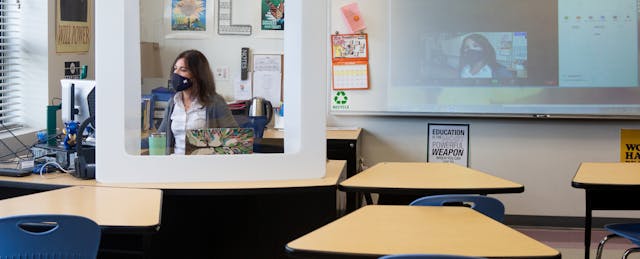Pamela Kramer had been careful.
The Illinois elementary school teacher stopped going to grocery stores and restaurants when the coronavirus pandemic began to surge in March. When she was ordered back into her Highland Park classroom to teach her remote fourth graders, Kramer arrived on campus early each morning and wore two masks. She even stopped drinking water during the day to avoid trips down the hall for bathroom breaks.
Kramer, 63, still ended up in the hospital in October. Not with COVID-19一her pre-existing heart condition was exacerbated by stress and dehydration and landed her in the ER.
“Every day, I felt chest pains,” she says of returning to campus. “The doctor says as an aside, ‘Just stay away from stress.’ I went out to the car and told my husband, ‘I can’t go back.’”
Kramer isn’t alone. Teachers across the country have been calling for a return to or expansion of remote learning, especially as students return from traveling and family gatherings over Thanksgiving break and health experts predict a winter surge in COVID-19 cases.

While many schools delayed reopening in the fall to flesh out safety protocols, those new measures have done little to assuage the fears of teachers who are back on campus.
An Illinois Education Association poll of over 1,300 members in October found that one-third had considered a career change this year. Sixty-nine percent feel it is “not very” or “not likely at all” that schools could safely reopen for full in-person learning in the spring. That’s despite most of the respondents reporting their schools have policies on safety measures like face coverings, social distancing and cleaning schedules.
Kathi Griffin, president of the Illinois Education Association, the state’s largest union, says her organization is not against schools reopening. What they want are safe reopenings and protocols that reflect the COVID-19 health risks in schools’ surrounding areas.
“If it is unsafe for the community, we need to make sure we say it isn’t safe for anybody in our schools,” she says.
Weighing the Options
About 40 miles south from Kramer, 26-year-old Mariah Klein teaches second graders—six in-person, 17 remote—in Glendale Heights, Ill. She loves teaching at the elementary school she attended as a kid, and her former teachers are now her colleagues.
But Klein says being at school during a pandemic has left her constantly worried and exhausted. The stress is causing her to lose hair and making it harder to sleep. It prompted Klein and her husband to take a serious look at their finances to see if they can stay afloat without her teaching salary. The numbers added up, but she hasn’t decided to leave.
“I truly love my job. My principal is great, my coworkers are great, and I don’t think I'll ever find a job I love as much as this one,” Klein says. “What bothered me the most is it didn’t matter what the data looked like. We were staying open.”
Bree Dusseault is practitioner-in-residence at the Center on Reinventing Public Education and part of a team analyzing 100 school districts’ responses to COVID-19 based on publicly available information. In September, most districts announced changes to building usage, cleaning protocols and behavioral norms to prevent coronavirus spread.
It’s tough to glean how those plans played out once school doors reopened. Dusseault says districts haven’t changed what they’re publicly communicating about safety but aren’t adding new measures. Many are focused on reaffirming existing safety protocols and assuring families that it’s safe for students to return to campus.
“What we are seeing is that districts are absolutely holding health and safety in one hand and students’ long-term learning experiences and long-term success in the other hand, and they’re trying to weigh those two tension points to make the best decision that they can,” she says. “How they make those decisions really do seem to differ based on external factors. When it comes to deciding which learning mode a district is in—be it remote, hybrid or in-person—who has a seat at that decision-making table really matters.”
She pointed to a recent study from researchers at the Annenberg Institute at Brown University, which found that while the intensity of COVID-19 cases impacted how over 10,000 districts started the school year, the pandemic didn’t affect reopening policy later into the semester. Rather, it’s the political leanings of the region coupled with the strength of labor unions that have determined how instruction is delivered. More conservative regions of the country that were strongholds of support for President Trump were far more likely to reopen schools, while Democratic-leaning regions tended to favor fully remote learning. School districts with strong teacher unions also tended to hold off sending students back to campus.
That shattered researchers’ view of school boards as non-partisan boards of community members that rely on professional expertise to make decisions about safety. The researchers wrote that their findings upend “much conventional wisdom about local education politics and policy in the United States.”
In a similar vein, EdSurge analysis found that districts in states where COVID-19 positivity rates were higher were more likely to offer in-person instruction than those in states where infection rates were lower.
Andy Dewey, executive vice president of the Houston Federation of Teachers, said educators are especially worried about class size and social distancing. Some teachers have reported classes with more than 20 students and, depending on the age and size of the building, don’t have more than 3 feet between students.
“Overwhelmingly, at least the [teachers] who have spoken to us don't feel safe in their return. They don’t feel the administration has really delivered on all the safety measures they were promised,” he says.
Dewey’s group asked Houston ISD to go fully online after Thanksgiving, but students were back in school on Monday. Dewey gets the sense administrators would be willing to expand remote learning if not for the state’s education agency’s push for in-person teaching.
“They keep citing the fact that the state agency that controls the money is threatening to hold funding back if they go all virtual,” he says.
Even in areas where administrators are doing things right, teachers’ concerns about safety linger.
Mike Williamson, Illinois Education Association bargaining president for District 300, in a Chicago suburb, says the school board put safety at the forefront of their decisions, even though it drew criticism from community members who wanted children to return to classes like they would any other fall. Schools have been remote for most of the fall, he says, and the district announced Monday classes will remain virtual until January.
Opinions on school reopening among teachers in his group run the gamut, he says. Some would happily be back in front of their classes tomorrow if given the chance. Others don’t want to set foot on campus at all.
“Our superintendent and board tied whether we were going to be in school [to] health metrics and hospital beds,” says Williamson, “We don’t always agree. This pandemic has been hard on everyone, but I think they have been listening to us.”
Setting a Standard
Dusseault says one challenge for determining when schools can safely reopen is that thresholds look different throughout the country. States created their own frameworks based on the rate of new COVID-19 cases, but some were publicized as recommendations rather than requirements.
“There are no universal standards on what is considered safe or not safe. Especially given that we’re going to be under a new administration soon, clear federal and state guidance would ideally be anchored on national standards of health recommendations and not politics,” she says. “That would really benefit students and families as well as teachers so there is clarity on what can be expected and a little more universality on what is considered safe and not safe.”
One piece of advice Dusseault has for school administrators: err on the side of transparency.
“Over-communicate data, decisions, rationale. Those are all things that一while they don’t provide answers to all the questions we have一help provide context for parents and teachers and students to make informed decisions and not feel like we’re grappling in the dark as much as we may be feeling right now,” she says.
While she started the year teaching remotely, Kramer, the fourth grade teacher, says that her disability request to be exempted from conducting her virtual classroom from campus was denied. The in-person safety protocols provide little reassurance as she thinks about the long-term health impacts contracting COVID-19 could have.
Kramer sees debate over reopening schools as another stark sign of the national political divide. Some argue that in-person classes are what’s best for students, but what’s best is for students to be able to finish their school year with the teacher who was there from the start, she says.
“I think at this point there is no such thing as a safe classroom,” she says, especially for teachers with underlying health conditions or who live with at-risk family members. “When the numbers go low, there’s still a risk for people like me.”
After her hospitalization, Kramer took time off to stay home and mull over her professional path forward. The district returned to fully remote teaching while she was on leave.
When Kramer pictures in-person classes in the winter, windows closed against the biting Midwestern cold, she just doesn’t see how having even 10 students in an enclosed space would be safe. Still, she predicts her superiors will insist she return to campus when schools reopen again.
“I feel no stress, and I’m doing OK,” she says of teaching from home. “I will not go back. And if [COVID-19 case] numbers get better in the spring, I will retire. I just can’t risk my life and the stress of destroying my heart.”


